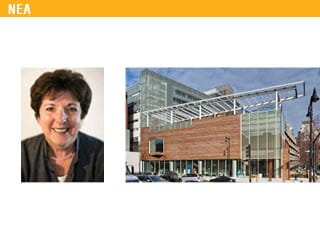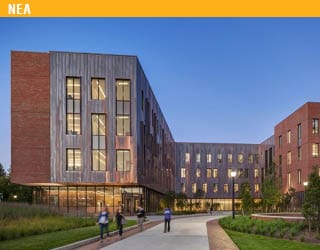Interview with Ms. Andrea Leers of Leers Weinzapfel Associates
Spyros Th. Spyrou
Nicosia, Tuesday the 2nd of December 2014
You do not choose Architecture, it chooses you. It is not an entirely rational choice. You do it because you are interested in the physical world around you. It’s a great kind of work and it takes you into every part of life, Ms Andrea Leers stated.
“…Cyprus is a beautiful place. I especially enjoyed the drive to Paphos, through the hills, where you could see, before development, the natural quality of the dry hilly landscape and the distant sea…”
Andrea Leers, FAIA is a principal and co-founder of Boston-based Leers Weinzapfel Associates, the first and only woman-owned firm to win the distinguished American Institute of Architects Firm Award (2007). Ms. Leers has taught at a number of schools including Harvard University, Graduate School of Design; University of Virginia, School of Architecture; and the Yale University, School of Architecture.
I had the chance to talk to Ms. Leers the day after she gave an interesting lecture, entitled «Making Connections: design across scales, disciplines, cultures», in memory of Mr. George Paraskevaides, organized by the University of Cyprus with the valuable support of the family of Mr George Paraskevaides and of the Department of Architecture. After only a few hours on the island, her passion for seeing new places and learning about the local culture, led her to visit some of the cities and cultural heritage sites of Cyprus. With a trained and experienced eye she observed: “I had almost three days to explore Cyprus and see Paphos, Limassol, Larnaca, and Nicosia. Cyprus is a beautiful place. I especially enjoyed the drive to Paphos, through the hills, where you could see, before development, the natural quality of the dry hilly landscape and the distant sea. I was interested, too, in the different ways sea side towns have developed. So Paphos had its own character, Limassol another, and from what I could see at night, Larnaca was still had another. Each seems to have its own personality.”
S.Th.S.: Let’s begin from the basics… Why become an Architect? What fascinated you about architecture?
A.L.: I was not a child who dreamed about being an architect, the way that some people come to it. I had been interested in the arts in general, painting and drawing in particular. I was interested in the visual world and I thought for quite a while I might be a painter. In college I came to know some students of architecture, and what they were doing seemed exciting to me, and I thought would try it. Since I graduated in mid-year and I had one semester before I had to make serious long term plans, I took that semester to do an architectural studio at MIT, as they allowed me to be a special student. And at the end of that semester, I thought “this is really interesting, I’ll try it.” I applied to schools and was accepted, and the more I was exposed to architecture, the more interested I became. So it was a gradual choice, but it grew out of my interest in the visual world.
S.Th.S.: An old teacher of mine used to say that when it comes to a good book one has to read it three times. When he/she is a teenager, when a grown up and last when grown old. For you, what did Architecture mean before commencing your studies, how did you conceive architecture when first going into practice and how do you approach it now after all these years of experience.
A.L.: When I first started to study architecture I was struck by how exciting it felt when you were doing the right thing and how devastating it felt when you couldn’t find that right way. There were a lot of ups and downs. That characterized my early studies and my early years of practice- there was elation and sometimes almost despair, a big contrast between feeling good and feeling uncertain. After many years of practice and teaching I began to understand what was really important to me, where my strengths were, and what my values were. I think a lot of that realization came through teaching. The need to explain to young people as a teacher forces you to think about what your own values are. It was through that process, maybe ten years into teaching and practice that I really came to understand better my own goals and my own work and it was at that time I really, finally learned the lessons from architecture school. In school we see it, we try it, we copy it, we do it almost as an automatic exercise. Ten years later, when you have tried to create your own buildings and do your own design work, then you remember the lessons from school… now they have meaning for you. In the beginning everything is new, and it’s hard to know what to pay attention to first. I remember when I was in school, at the University of Pennsylvania, when the great Louis Khan was the head of the school, that we knew he was a very important, inspirational and creative architect. We listened and copied what he did, but we didn’t really understand it. It was only many years later when I saw some of his buildings again, after I had been working and teaching, that I fully understood his lessons. It takes time and experience to absorb things as complex as architecture and the arts.
S.Th.S.: What is “Contemporary Architecture” for you?
A.L.: Contemporary is what we do now as compared to modern, which is an historic term; it refers to early and mid twentieth century architecture with a specific language that came to be understood, together with art and literature, as “modern”.
S.Th.S.: Can we talk about trends in the Global Architectural Culture?
A.L.: There are a couple of large forces that work right now that are affecting designers all over the world. One is the revolution of information and digital technology, which affects the way we draw, the way we conceive form, the way we represent form, the way we analyze conditions. All of these activities have been dramatically changed through very powerful digital tools. The other big trend, I think, is the realization of our finite global resources. Using too much energy, coping with rising waters, and global warming are powerful issues that affect our built environment and change everything we do. In addition to these global forces, there are, of course, many local factors which drive design- climate, topography, social, cultural, and physical building history. Together, both the global and the local understandings inform design.
S.Th.S.: So the role of the Architect should be using technology or developing technology?
A.L.: We do both; of course we use it but we are developing it too. In terms of representational tools, every generation of students figures out something new and different and exciting to do with the tools that exist, in a kind of a constant invention. And then the technology of building is constantly evolving; in almost every one of our projects, we find ourselves inventing some new assemblies that don’t exist so that we can fulfill a certain need. It’s a normal part of what we do!
S.Th.S.: What is the importance of innovation in your office?
A.L.: We are working on new materials and new uses for old materials. I spoke at the lecture about one of our projects for a design school, where one of the subjects of their research is engineered timber. Because the school is in a rural part of the state, the history of that school is that they are very interested in the use of the landscape and natural resources. So a very old material is being re-imagined and re-researched as an engineered building product. That means that timber is being assembled and laminated with glues and fastenings to give it greater strength and durability. Together with very special experts in this area we are actually inventing a new system from a very old material.
There are many different models of cities. In Europe the models are based on very well established historic cores and the challenge there is how to grow well. In Paris the historic core is preserved and growth can only occur at the periphery, whereas in London the city has transformed at its core and grows seamlessly outward.
S.Th.S.: Andrea, you are a member of the Mayor’s Boston Civic Design Commission. What should the role of architects be in our society apart from designing buildings?
A.L.: As designers we are also citizens and we are part of a culture of discussion about the physical environment. It is essential that people who care a great deal about their city, their university, or their region actually lend their expertise and perspective to decision makers. In the case of the Mayor’s Commission in the city of Boston, it is very interesting work. Over twenty years ago the design community demanded and supported legislation to create a designer review board for all projects over a certain size in the city of Boston- the Boston Civic Design Commission. The eleven Commissioners must be residents of Boston, and they are architects, landscape architects, and design/developers. They have the interest of the city at heart and they review all large projects- commercial and residential developments, university expansions, and hospital growth, for their impact on the public realm. The emphasis is on what the proposals will do for the city, for pedestrians, and for the ensemble of all the buildings in the city. It takes a significant volunteer effort and it is rewarding because you feel that you can make a difference. The Commissioners include some of the top architects in the city, willing to share their perspective, thinking not about their own projects but about the good of the public realm.
S.Th.S.: How do you see our cities being shaped in the future and what is the role of architecture in growing cities?
A.L.: There are many different models of cities. In Europe the models are based on very well established historic cores and the challenge there is how to grow well. In Paris the historic core is preserved and growth can only occur at the periphery, whereas in London the city has transformed at its core and grows seamlessly outward.
North American cities and to some extent South American cities have a different challenge. We have a lot of space and we have taken it up. The cities of America are sprawling, and our challenge is how to not just keep eating into the land indefinitely, but how to wisely densify the core, improve public transportation, and create public ground. In Europe there has always been a priority for communal space, such the plaza in front of the church and town hall.
Asia is another case altogether. Asia has a new model for the city that is unlike anything in the West and they are growing so rapidly and so densely that the Western models just do not apply. The danger there, in China especially, is that cities are developer driven. They are not planned cities with a mix of uses and public amenities. Public infrastructure barely keeps up with the growth and planning is by default.
S.Th.S.: What’s the role of social engagement in city formation?
A.L.: I would say that the public approvals process for any major project has definitely grown stronger over the years, certainly in the United States. There are some examples in Asia where very strong neighborhood groups get together and push back against the developers. One of the studios that we did at Harvard, “Tokyo’s Book City”, dealt with a special neighborhood at the heart of the old city. Jimbocho is a wonderful neighborhood with small buildings selling antique and contemporary books. It was a prime development target right in the middle of town. The neighborhood said “let’s work together to figure it out- where its ok to do big buildings, and where not”. Our studio met with the neighborhood people, the public officials, and some of the developers too. We heard what each of them was hoping would happen, and the students made proposals which mixed development and preservation. This kind of public process does have an impact to some extent.
S.Th.S.: In your work I see a series of program specific projects… Starting with Court Houses and onto Health Centers and to Academic institutes… does specialization exist in the field of Architecture?
A.L.: It certainly does. There are certain areas where it’s very important, like hospital design. Hospitals are very complex machines and so there are firms that have that specialized knowledge. Although we have done multiple courthouses recreational centers, and academic buildings, those are areas that have more general programs. Even a courthouse which is a fairly complex building is not rocket science; you can learn the rules of planning pretty easily, I taught a course in courthouse design for more than ten years, and year after year people came to learn the “secrets,” even though it’s not a big mystery. In fact what I enjoy most about architecture is not being a specialist. I enjoy working with each new user group and understanding what they need; it’s the learning process which is so stimulating. Of course if you have worked with that kind of group before then you already understand their needs and you can offer them options.
…However the need for building things goes on and what happens is that clients and architects become very resourceful about figuring out how to get what they need done with fewer means at their disposal…
S.Th.S.: Which things outside the field of architecture inform your work?
A.L.: For me it is all about the life and experience of other places. I really enjoy learning about other cultures, understanding what people are like so as to make their environments in the way they do. Earlier on in my career I had the chance to go to India for the first time, and I went to Delhi. I was absolutely blown away by Humayun’s tomb; it was an enormous powerful structure, and something that had a huge impact on me. During my years in Japan, I came to appreciate their love of the art of construction, and the quality of the light which is very different than the way we think of it in the West. We create spaces of bright light and a dark shade; they have a very filtered and modulated approach to light. I never try to design something like a Japanese building or derivative of any other culture, but observing other cultures has certainly become a part of my own perception.
S.Th.S.: I could not leave behind a subject that shaken us, the Economic Crisis… acting as a repression of the architectural discipline or as an awakening opportunity!
A.L.: Of course what happens in a recession is that the very first thing we stop is building. We are very dependent as a profession on the business cycle in that sense. However the need for building things goes on and what happens is that clients and architects become very resourceful about figuring out how to get what they need done with fewer means at their disposal. For example, in the last recession many of the university clients were building very ambitious projects, especially big science facilities, new campuses and so on. With the recession, universities retreated to think about priorities, and concluded that some of these projects could be renovations, and that some of them could be reduced in size. A tightening of priorities happened. Both clients and designers became very resourceful. During the hiatus of building, many architecture firms failed, but those that survived became more resourceful in helping their clients think about ways to achieve what they need to do differently. Some good things come out of it; adversity invites invention.
S.Th.S.: What would you recommend to someone who wants to study architecture?
A.L.: Architecture is a passion. It is something that chooses you; it is not an entirely rational decision. It is a very hard work, and it is not very well paid. In all of those ways, it is not a very rational route, but people choose it when they care deeply about the physical world around them. They choose it because they believe that by making things, they can make life better for people; they choose it because they like to make beautiful things, and share beautiful things with others. These are the things that cause people to love architecture, and I am always surprised that even through the recession, at Harvard we just kept getting increasing numbers of applicants despite the economic data, despite the fact that there were hardly any jobs out there. People are idealistic about improving the environment, about making a better life for people, of having a social benefit to what they do, of making something of great beauty that would be satisfying to themselves and appreciated by others. It continues to amaze me that people choose it when being a lawyer would be much more sensible. I certainly never looked back; it’s a great kind of work and it takes you into every aspect of life.
From the closing remarks of Ms. Andrea Leers’ Lecture:
“When we began our practice, our work was centered on the design of self-contained buildings in our home community of Boston. This was how we learned our craft. Since that time the revolution in digital technology, the urgency of increased urbanization, and the awareness that we are overusing our one planet’s resources have dramatically altered the nature of practice. Today we are working simultaneously at multiple scales, from the carefully crafted object to extended territories. We are weaving together the thinking of previously separate disciplines to create ensembles of building, landscape, and infrastructure. We are working across cultures to find connections and distinctions between the urban and social contexts of Boston, Paris, Tokyo, and Taiwan. Today, our tools and collaborations have dramatically changed but our fundamental concerns remain the same: making connections between people and place, between history and the future, between the conceptual and the tectonic.”







